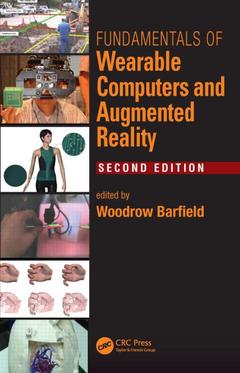Description
Fundamentals of Wearable Computers and Augmented Reality (2nd Ed.)
Coordinator: Barfield Woodrow
Language: English
Subjects for Fundamentals of Wearable Computers and Augmented Reality:
Keywords
AR; AR System; Augmented Reality Storytelling; Wearable; Haptic Augmented Reality; AR Application; Head-Mounted Display; Camera Pose; Scalable Augmented Reality; Reprojection Error; wearable tech; Google Glass; wearable technology; Pose Estimation; Virtual Objects; Haptic Rendering; Half Silvered Mirror; Haptic Device; Spatial Sound; Extrinsic Camera Parameters; Point Cloud; AR Visualization; Bend Sensors; Wearable Systems; RGB Camera; Intrinsic Camera Parameters; Virtual Force; Optical Combiner; Smart Phone; Spatial Audio; Contact Lens
Publication date: 08-2015
· 15.6x23.4 cm · Hardback
Publication date: 07-2017
721 p. · 15.6x23.4 cm · Paperback
Description
/li>Contents
/li>Biography
/li>
Data will not help you if you can?t see it where you need it. Or can?t collect it where you need it. Upon these principles, wearable technology was born. And although smart watches and fitness trackers have become almost ubiquitous, with in-body sensors on the horizon, the future applications of wearable computers hold so much more. A trusted reference for almost 15 years, Fundamentals of Wearable Computers and Augmented Reality goes beyond smart clothing to explore user interface design issues specific to wearable tech and areas in which it can be applied.
Upon its initial publication, the first edition almost instantly became a trusted reference, setting the stage for the coming decade, in which the explosion in research and applications of wearable computers and augmented reality occurred. Written by expert researchers and teachers, each chapter in the second edition has been revised and updated to reflect advances in the field and provide fundamental knowledge on each topic, solidifying the book?s reputation as a valuable technical resource as well as a textbook for augmented reality and ubiquitous computing courses.
New Chapters in the Second Edition Explore:
- Haptics
- Visual displays
- Use of augmented reality for surgery and manufacturing
- Technical issues of image registration and tracking
- Augmenting the environment with wearable audio interfaces
- Use of augmented reality in preserving cultural heritage
- Human-computer interaction and augmented reality technology
- Spatialized sound and augmented reality
- Augmented reality and robotics
- Computational clothing
From a technology perspective, much of what is happening now with wearables and augmented reality would not have been possible even five years ago. In the fourteen years since the first edition burst on the scene, the capabilities and applications of both technologies are orders of magnitude faster, smaller, and cheaper. Yet the book?s overarching mission remains the same: to supply the fundamental information and basic knowledge about the design and use of wearable computers and augmented reality with the goal of enhancing people?s lives.
Introduction. Basic Concepts in Wearable Computers and Augmented Reality. Augmented Reality: Approaches and Technical Challenges. Mobile and Pervasive Computing. Technology. A Survey of Tracking Technology for Virtual Environments. Optical Versus Video See-Through Head-Mounted Displays. Augmenting Reality Using Affine Object Representations. Registration Error Analysis for Augmented Reality Systems. Mathematical Theory for Mediated Reality and Wearcam-Based Augmented Reality. Augmented Reality. Studies of the Localization of Virtual Objects in the Near Visual Field. Fundamental Issues in Mediated Reality, and Camera–based Augmented Reality. Star: Tracking for Object-Centric Augmented Reality. Wearable Computers. Computational Clothing and Accessories. Situation Aware Computing with Wearable Computers. Collaboration with Wearable Computers. Tactual Displays for Sensory Substitution and Wearable Computers. Photographic/Videographic Applications of Wearcomp–based Augmented/Mediated Reality. Military Applications of Wearable Computers and Augmented Reality. Medical Applications for Wearable Computing. Applications of Wearable Computers and Augmented Reality to Manufacturing.Computer Networks for Wearable Computing. Computing Under the Skin. Human-Computer Interface Design Issues. Enhancing Humans with Technology. Body Hacking and Wearable Computers. Wearable Prosthesis. References. Index.
Woodrow Barfield, PhD, JD, LLM, has served as professor of engineering at the University of Washington, Seattle, Washington, where he received the National Science Foundation Presidential Young Investigator Award. Professor Barfield directed the Sensory Engineering Laboratory, where he was involved in research on sensors and augmented and virtual reality displays. He has served as a senior editor for Presence: Teleoperators and Virtual Environments and is an associate editor for Virtual Reality. He has more than 350 publications and presentations, including invited lectures and keynote talks, and holds two degrees in law.




